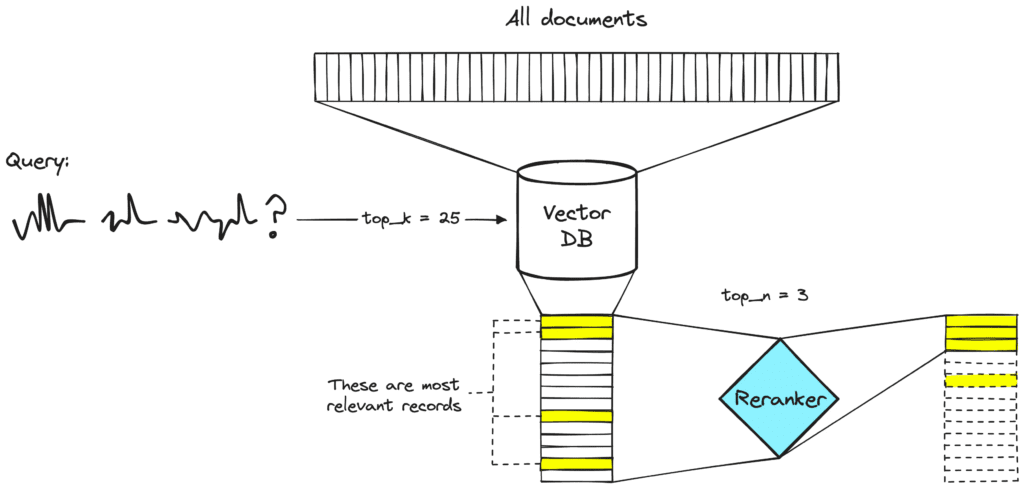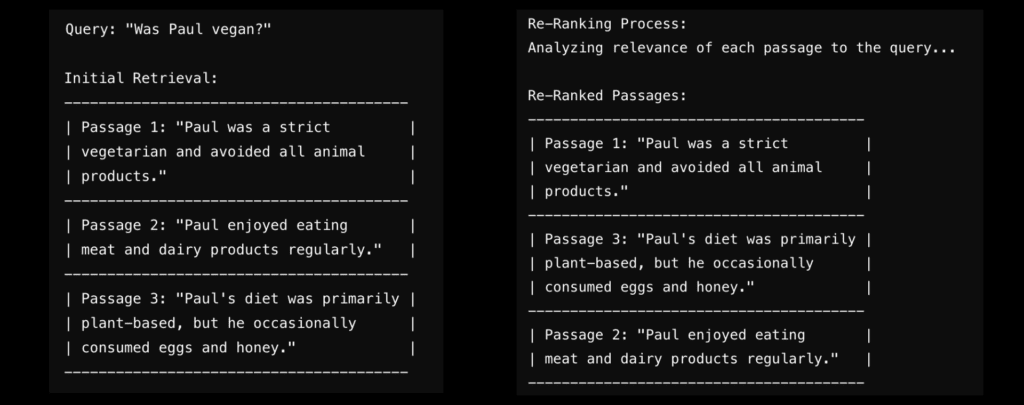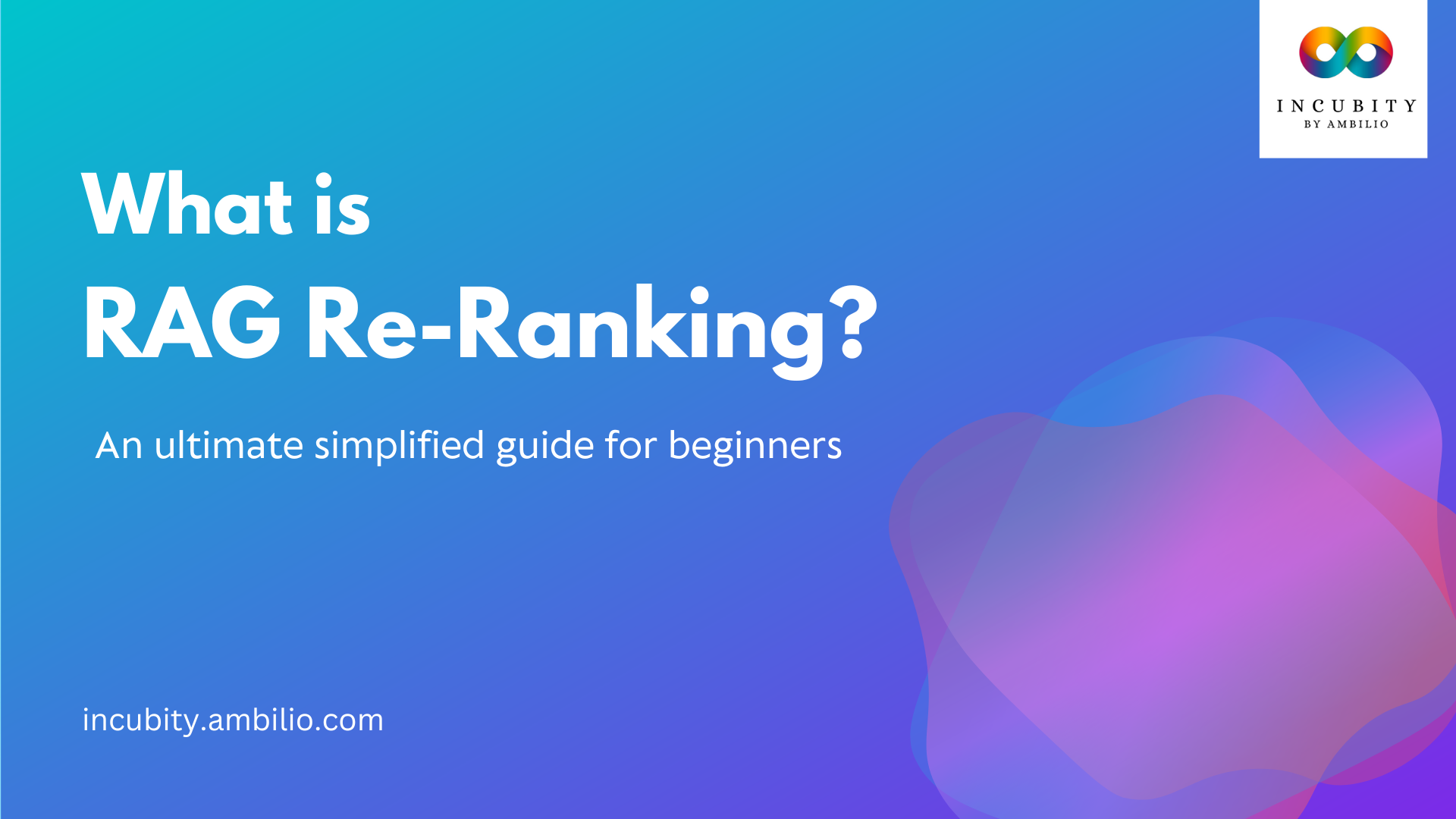Retrieval Augmented Generation (RAG) is an advanced technique in NLP that enhances the capabilities of large language models (LLMs) by incorporating external information retrieval. By combining the strengths of retrieval-based methods with generative models, RAG systems can provide more accurate and contextually relevant responses to queries. One crucial component of an effective RAG pipeline is re-ranking. RAG Re-ranking is the process of reordering and filtering the retrieved documents or passages to ensure that the most relevant ones are prioritized and presented to the LLM. This article will delve into what RAG is, explain the concept of re-ranking, discuss how it works, and highlight its benefits.
What is RAG?
Retrieval-Augmented Generation (RAG) is an advanced technique in natural language processing that enhances the capabilities of large language models (LLMs) by incorporating external information retrieval. This approach optimizes the output of an LLM by allowing it to reference an authoritative knowledge base outside of its training data sources before generating a response.
RAG combines three primary processes: retrieval, augmentation, and generation:
- Retrieval:
- In this stage, the system uses a retrieval model to fetch a set of potentially relevant documents or passages from a large knowledge base.
- This model can employ various methods such as TF-IDF (Term Frequency-Inverse Document Frequency), BM25, or more advanced neural retrieval techniques like dense passage retrieval.
- The objective is to gather a broad set of documents that might contain the information needed to answer the query accurately and comprehensively.
- Augmentation:
- After retrieving the relevant documents, the system uses this information to augment the user’s original query.
- This involves incorporating the retrieved data into the input prompt for the LLM, effectively enriching the context in which the model operates.
- This step uses techniques like prompt engineering to ensure that the added information is seamlessly integrated and enhances the model’s understanding of the query.
- Generation:
- With the augmented prompt, the generative model (typically a large language model like GPT-4) processes these documents to generate a coherent and contextually appropriate response.
- The generative model synthesizes information from multiple documents, integrating the retrieved data with its own training to provide a more informed and comprehensive answer.
- This allows the LLM to produce output that is not only contextually relevant but also backed by up-to-date and authoritative information sources.

Source: AWS
By combining these three processes, RAG systems can deliver more accurate, relevant, and useful responses, leveraging the latest information without needing to retrain the underlying LLM on new data. This makes RAG a cost-effective and powerful tool for improving the performance of LLMs in various applications.
How Does Re-Ranking Work in RAG?
Re-ranking is essential in a RAG system because it ensures that the most relevant documents are used by the generative model. The process involves two main steps:
- Initial Retrieval: The first step is to retrieve a broad set of potentially relevant documents or passages using a fast but less precise method, such as vector search. This initial retrieval step casts a wide net, gathering a large number of potentially relevant sources. This stage is crucial for ensuring that no potentially relevant information is overlooked.
- Re-Ranking: The second step involves using a more sophisticated re-ranking model to evaluate the relevance of each retrieved document or passage in relation to the original query. This re-ranking model, often based on advanced techniques like cross-encoder architectures (e.g., BERT), can consider the nuances and complexities of natural language to provide a more accurate assessment of relevance.

Source: Pinecone
The re-ranking model assigns a relevance score to each retrieved item. The items are then reordered based on these scores, ensuring that the most relevant documents or passages are placed at the top of the list, while less relevant or irrelevant items are pushed down.
Benefits of Re-Ranking in RAG
Re-ranking enhances the performance of RAG systems in several ways:
- Improved Relevance: By prioritizing the most relevant documents or passages, the re-ranking step helps to ensure that the information provided to the LLM is highly relevant to the user’s query. This leads to more accurate and contextually appropriate responses from the LLM.
- Reduced Noise: The re-ranking process helps to filter out irrelevant or less relevant information, reducing the “noise” that the LLM has to process. This improves the overall quality and coherence of the LLM’s responses, as it focuses on the most pertinent information.
- Enhanced Efficiency: By focusing the LLM’s attention on the most relevant information, the re-ranking step can improve the efficiency of the RAG pipeline. This reduces the computational resources required and potentially improves response times, making the system more practical for real-time applications.
- Increased Robustness: Re-ranking makes the RAG system more robust to variations in the input query or the retrieved documents. By considering the nuances of language and the relationship between the query and the retrieved information, the re-ranking model helps maintain high-quality responses even in the face of challenging or ambiguous inputs.
Example of Re-Ranking in Action

To illustrate the impact of re-ranking, consider a scenario where a user queries, “Was Paul vegan?” The initial retrieval might bring back the following passages:
- “Paul was a strict vegetarian and avoided all animal products.”
- “Paul enjoyed eating meat and dairy products regularly.”
- “Paul’s diet was primarily plant-based, but he occasionally consumed eggs and honey.”
Without re-ranking, the RAG system might present these passages in the order they were retrieved, leading to an ambiguous or incorrect answer. However, with re-ranking, the system analyzes the relevance of each passage to the query. The re-ranking model might determine that the first and third passages are more relevant to whether Paul was vegan and place them at the top, while the second passage, which contradicts the query, is ranked lower.
This prioritization ensures that the LLM receives the most relevant information, enabling it to generate an accurate and informative response to the original query.
Implementation of Re-Ranking in RAG
Implementing re-ranking in a RAG system involves several steps:
- Data Collection: Gather a dataset that includes pairs of queries and their corresponding relevant documents or responses. This dataset will be used to train and evaluate the retrieval and re-ranking models.
- Pre-Processing: Tokenize and clean the text data. Create an index for efficient retrieval. This step ensures that the data is in a format suitable for the models to process.
- Model Architecture:
- Retrieval Model: Choose or design a retrieval model to fetch relevant information from the knowledge base. This could be based on traditional methods like TF-IDF or BM25, or modern neural retrieval models like dense passage retrieval.
- Re-Ranking Model: Use a cross-encoder model (e.g., BERT) to score the relevance of each retrieved document in the context of the query.
- Integration: Combine the retrieval and re-ranking models. Feed the retrieved information into the re-ranking model for scoring and reordering.
- Training: Pre-train the retrieval model on the knowledge base. Fine-tune both models on your specific dataset to improve their performance.
- Evaluation: Evaluate the model using relevant metrics such as retrieval accuracy, fluency, coherence, and task-specific metrics. This step ensures that the system meets the desired performance criteria.
Final Words
Re-ranking is a crucial component of an effective RAG pipeline. It helps to improve the relevance of the retrieved documents, reduce noise, enhance efficiency, and increase the robustness of the system. By leveraging advanced techniques like cross-encoder architectures, re-ranking models provide a more nuanced assessment of the relationship between the query and the retrieved information. This leads to better-quality responses from the LLM, making RAG systems more powerful and effective for a wide range of applications. As the technology evolves, the importance of re-ranking will continue to grow, making it an essential tool for anyone working with AI-driven search and generation systems.



